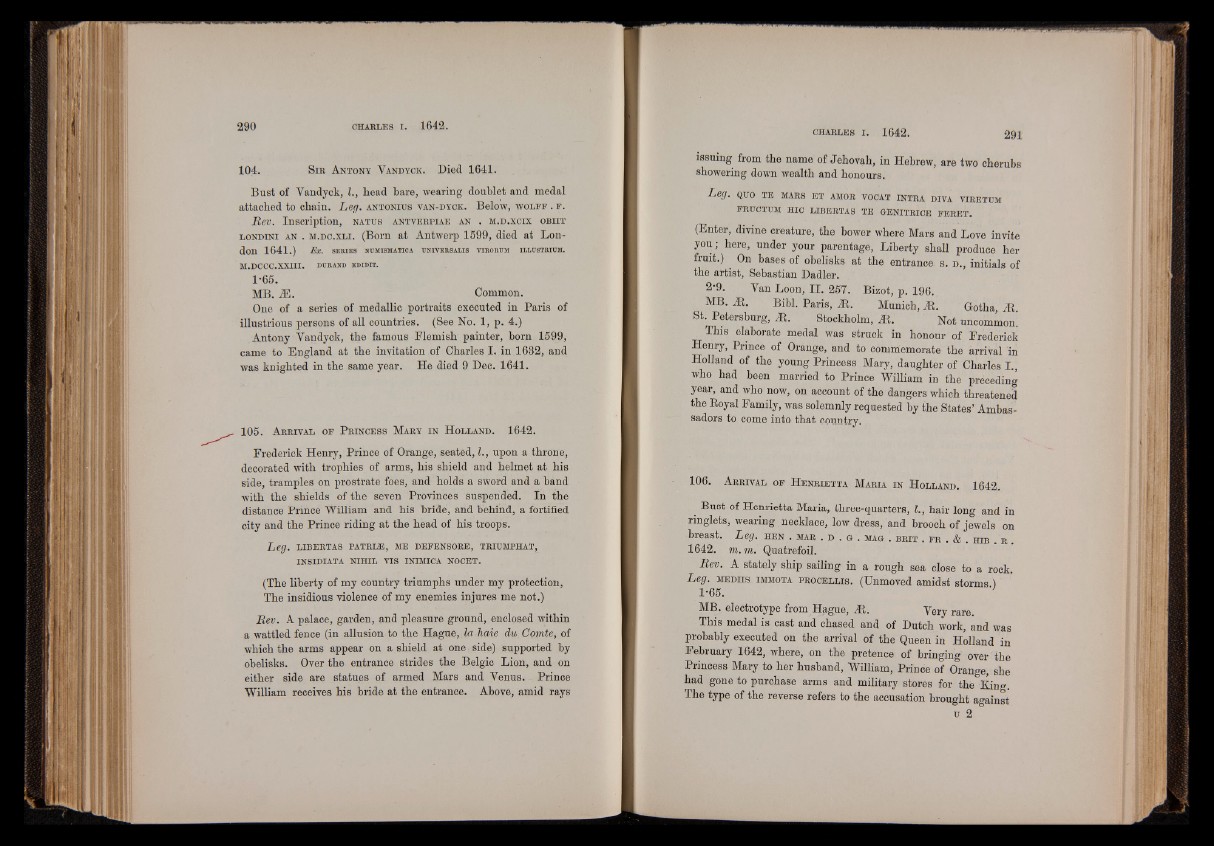
Bust of Yandyck, I., head bare, wearing doublet and medal
attached to chain. Leg. antonitjs van-dyck. Below, w o l f f . f .
Rev. Inscription, n a t u s a n t v e r p i a e a n . m .d .x c ix o b i i t
l o n d i n i a n . m .d c .x l i . (Born at Antwerp 1599, died at London
1641.) Ex. SERIES NUMISMATIC A UNIVERSALIS VIRORUM ILLUSTRIUM.
M.DCCC.XXIII, DURAND EDIDIT.
1-65.
MB. iE. Common.
One of a series of medallic portraits executed in Paris of
illustrious persons of all countries. (See No. 1, p. 4.)
Antony Yandyck, the famous Flemish painter, born 1599,
came to England at the invitation of Charles I. in 1632, and
was knighted in the same year. He died 9 Dec. 1641.
105. A r r iv a l o f P r in c e s s M ary in H o l l a n d . 1642.
Frederick Henry, Prince of Orange, seated, L, upon a throne,
decorated with trophies of arms, his shield and helmet at his
side, tramples on prostrate foes, and holds a sword and a band
with the shields of the seven Provinces suspended. In the
distance Prince William and his bride, and behind, a fortified
city and the Prince riding at the head of his troops.
Leg. LIBERTAS PATRL®, ME DEFENSORE, TRIUMPHAT,
INSIDIATA NIHIL VIS INIMICA NOCET.
(The liberty of my country triumphs under my protection,
The insidious violence of my enemies injures me not.)
Rev. A palace, garden, and pleasure ground, enclosed within
a wattled fence (in allusion to the Hague, la haie du Comte, of
which the arms appear on a shield at one side) supported by
obelisks. Over the entrance strides the Belgic Lion, and on
either side are statues of armed Mars and Yenus. Prince
William receives his bride at the entrance. Above, amid rays
issuing from the name of Jehovah, in Hebrew, are two cherubs
showering down wealth and honours.
Leg. quo t e mars e t amor vooat in t r a diva v ir e t u m
FRUCTUM HIC LIBERTAS TE GENITRICE FERET.
(Enter, divine creature, the bower where Mars and Love invite
you; here, under your parentage, Liberty shall produce her
fruit.) ^ On bases of obelisks at the entrance s. d ., initials of
the artist, Sebastian Dadler.
2-9. Van Loon, II. 257. Bizot, p. 196.
MB. M. Bibl. Paris, riR. Munich, JR. Gotha JR
St. Petersburg, M. Stockholm, M . Not uncommon!
This elaborate medal was struck in honour of Frederick
Henry, Prince of Orange, and to commemorate the arrival in
Holland of the young Princess Mary, daughter of Charles I.,
who had been married to Prince William in the preceding
year, and who now, on account of the dangers which threatened
the Boyal Family, was solemnly requested by the States’ Ambassadors
to come into that country.
106. A r r iv a l o f H e n r ie t t a M ar ia in H o l la n d . 1642.
Bust of Henrietta Maria, three-quarters, I., hair long and in
ringlets, wearing necklace, low dress, and brooch of jewels on
breast. Leg. h e n . mar . d . g . mag . b r it . f r . & . h ib . r .
1642. m. m. Quatrefoil.
Rev. A stately ship sailing in a rough sea close to a rock.
Leg. m e d i is immota p r o c e l l is . (Unmoved amidst storms )
1-65.
MB. electrotype from Hague, rii. Very rare.
This medal is cast and chased and of Dutch work, and was
probably executed on the arrival of the Queen in Holland in
February 1642, where, on the pretence of bringing over the
Princess Mary to her husband, William, Prince of Orange, she
had gone to purchase arms and military stores for the King.
The type of the reverse refers to the accusation brought against
u 2